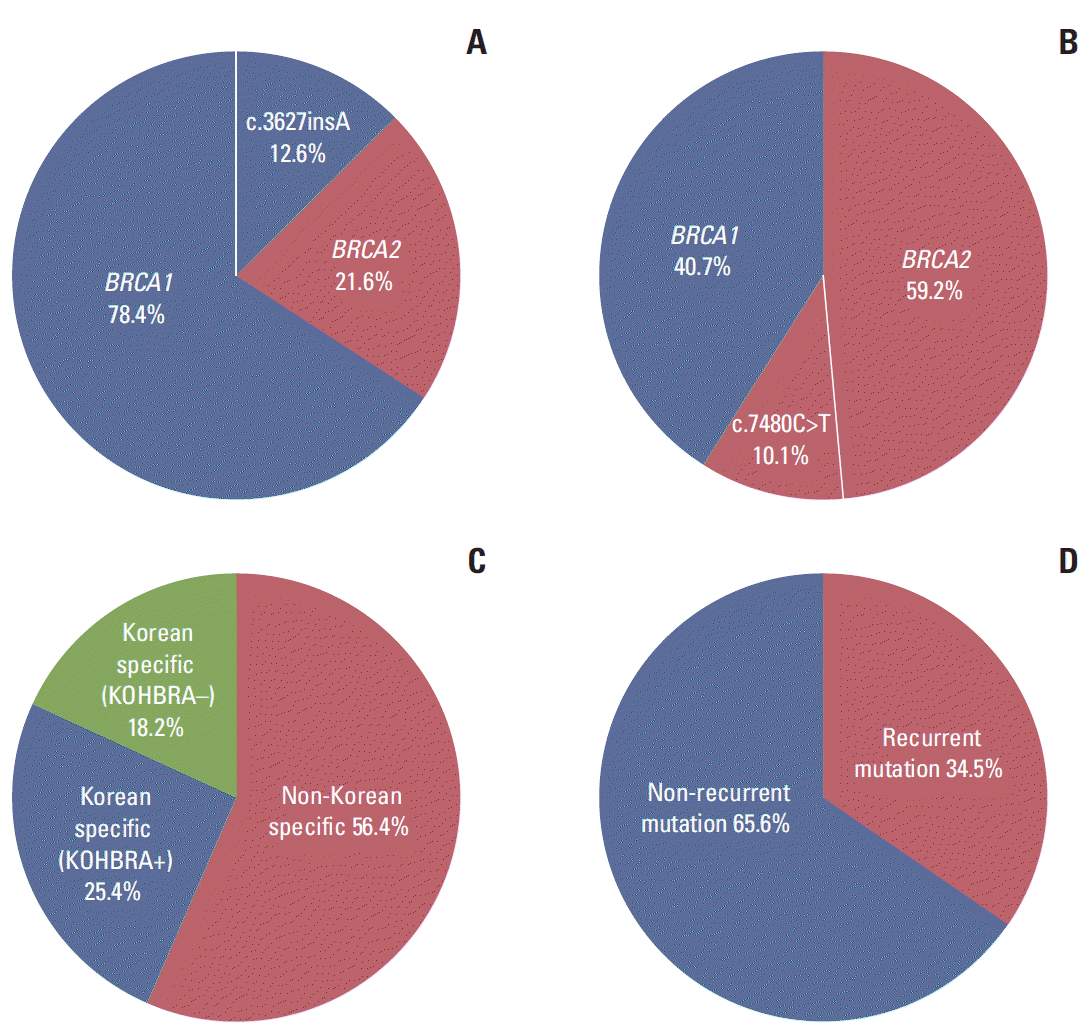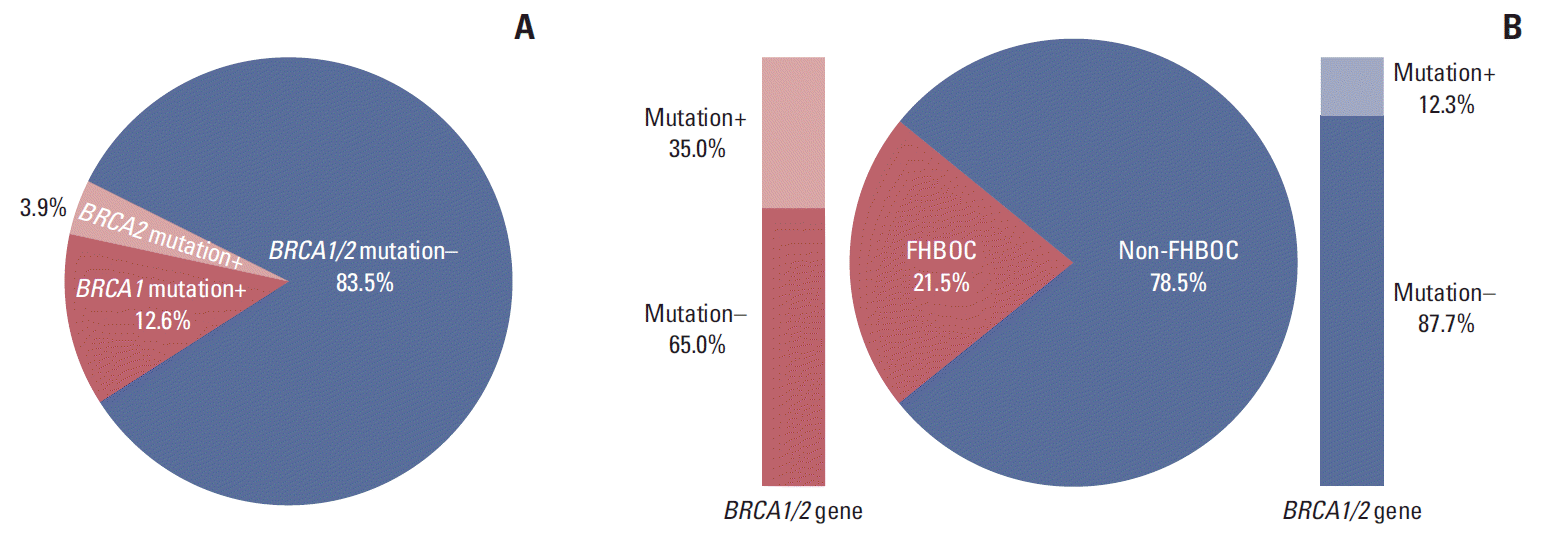Introduction
Materials and Methods
1. Patients
2. Direct sequencing
3. Statistical analyses
Results
1. Prevalence of BRCA1/2 mutations
2. Clinical characteristics of BRCA1/2 mutations
Table 1.
| Characteristic | Total | BRCA1/2 mutation– | BRCA1/2 mutation+ | p-valuea) |
|---|---|---|---|---|
| Total | 279 (100) | 233 (83.5) | 46 (16.5) | |
| Age (yr) | 54.15±10.7 | 54.2±10.9 | 53.7±9.6 | 0.765 |
| Age, early-onset (age < 50) | ||||
| < 50 | 93 (33.3) | 71 (30.5) | 18 (39.1) | 0.223 |
| ≥ 50 | 186 (66.7) | 162 (69.5) | 28 (60.9) | |
| FHBOCb) | ||||
| No | 219 (78.5) | 194 (83.3) | 25 (54.3) | < 0.001 |
| Yes | 60 (21.5) | 39 (16.7) | 21 (45.7) | |
| FH of other cancers | ||||
| No | 218 (78.1) | 190 (81.5) | 28 (60.9) | < 0.001 |
| Yes | 61 (21.9) | 43 (18.5) | 18 (39.1) | |
| Tumor histology | ||||
| Serous | 202 (72.4) | 160 (68.7) | 42 (91.3) | 0.002 |
| Non-serous | 77 (27.6) | 73 (31.3) | 4 (8.7) | |
| FIGO stage | ||||
| I/II | 96 (34.4) | 90 (38.6) | 6 (13.0) | 0.007 |
| III/IV | 183 (65.6) | 143 (61.4) | 40 (87.0) | |
| LN metastasis | ||||
| No | 190 (68.1) | 166 (71.2) | 24 (51.2) | 0.011 |
| Yes | 89 (31.9) | 67 (28.8) | 22 (48.8) |
Values are presented as number (%) or mean±standard deviation. FHBOC, family history of breast/ovarian cancer; FH, family history; FIGO, International Federation of Gynecology and Obstetrics; LN, lymph node.
Table 2.
| Characteristic | OR (95% CI) | p-value |
|---|---|---|
| Age (< 50 yr vs. ≥ 50 yr) | 1.762 (0.861-3.605) | 0.121 |
| FHBOCa) (yes vs. no) | 9.089 (3.204-25.783) | < 0.001 |
| FH of other cancers (yes vs. no) | 1.223 (0.861-2.653) | 0.747 |
| Tumor histology (serous vs. non-serous) | 3.834 (1.035-14.201) | 0.044 |
| FIGO stage (III/IV vs. I/II) | 3.738 (1.258-11.106) | 0.018 |
| LN metastasis (yes vs. no) | 1.143 (0.538-2.427) | 0.729 |
3. Spectrum of BRCA1/2mutations
Fig. 2.

Table 3.
| Site | Mutationa) | Type | No. of citations in KoOCb) | No. of citations in BIC | No. of citations in KOHBRA |
|---|---|---|---|---|---|
| BRCA1 (39 districts) | |||||
| 2 | c.1A>G | MS | 1 (1) | 8 | NR |
| 6 | c.277_279delTTTinsCC | FS | 1 (0) | 0 | NR |
| 7 | c.390C>A | NS | 8 (2) | 1 | R |
| 11 | c.922_924AGCinsT | NS | 5 (1) | 0 | R |
| 11 | c.928C>T | NS | 1 (0) | 0 | R |
| 11 | c.981_982delAT | FS | 1 (1) | 13 | R |
| 11 | c.1179_1180dupAG | FS | 2 (2) | 0 | NR |
| 11 | c.1716delA | FS | 2 (1) | 0 | R |
| 11 | c.1831delC | NS | 2 (2) | 0 | R |
| 11 | c.1953delG | FS | 1 (1) | 0 | NR |
| 11 | c.1962insT | FS | 2 (0) | 0 | R |
| 11 | c.2047delA | FS | 1 (0) | 0 | NR |
| 11 | c.2359delG | FS | 1 (0) | 0 | R |
| 11 | c.2433delC | FS | 4 (1) | 11 | R |
| 11 | c.2914G>T | NS | 1 (0) | 0 | R |
| 11 | c.3157delG | FS | 1 (0) | 0 | R |
| 11 | c.3296delC | FS | 1 (0) | 2 | R |
| 11 | c.3340G>T | NS | 1 (0) | 1 | R |
| 11 | c.3377_3378delATinsG | FS | 1 (0) | 0 | NR |
| 11 | c.3442delG | FS | 5 (2) | 2 | R |
| 11 | c.3607C>T | NS | 1 (0) | 36 | R |
| 11 | c.3627insA | FS | 14 (5) | 9 | R |
| 11 | c.3895C>T | NS | 1 (0) | 1 | R |
| 11 | c.3991C>T | NS | 2 (1) | 0 | R |
| 11 | c.4040_4041delGA | FS | 1 (0) | 0 | NR |
| 11 | c.4041_4042delAG | FS | 2 (0) | 0 | R |
| 16 | c.4801A>T | NS | 1 (0) | 2 | NR |
| 16 | c.4981G>T | NS | 1 (1) | 1 | R |
| 17 | c.5030_5033delCTAA | FS | 1 (1) | 17 | R |
| 18 | c.5080G>T | NS | 1 (1) | 12 | R |
| 18 | c.5102_5103delTG | FS | 1 (0) | 3 | R |
| 22 | c.5339T>Cc) | MS | 5 (2) | 1 | NR |
| 23 | c.5444G>A | NS | 2 (1) | 4 | R |
| 23 | c.5445G>A | NS | 3 (3) | 0 | R |
| 24 | c.5470_5477delATTGGGCA | FS | 1 (1) | 2 | R |
| 24 | c.5496_5506delGGTGACCCGAGinsA | FS | 4 (4) | 3 | R |
| IVS5 | c.212+1G>A | SP | 1 (0) | 6 | R |
| IVS6 | c.302-2A>C | SP | 1 (1) | 1 | R |
| IVS23 | c.5467+1G>A | SP | 2 (0) | 5 | R |
| BRCA2 (16 districts) | |||||
| 3 | c.276insA | FS | 1 (1) | 1 | R |
| 10 | c.1111A>T | NS | 1 (1) | 0 | NR |
| 10 | c.1399A>T | NS | 4 (1) | 2 | R |
| 11 | c.2259delT | FS | 1 (1) | 0 | R |
| 11 | c.2798_2799delCA | FS | 1 (1) | 1 | R |
| 11 | c.3599_3600delGT | FS | 1 (0) | 6 | R |
| 11 | c.3744_3747delTGAG | FS | 1 (0) | 8 | R |
| 11 | c.4207dupA | FS | 1 (1) | 0 | NR |
| 11 | c.5576_5579delTTAA | FS | 3 (1) | 29 | R |
| 11 | c.5656C>T | NS | 1 (1) | 2 | R |
| 13 | c.6952C>T | NS | 1 (1) | 5 | R |
| 15 | c.7480C>T | NS | 4 (0) | 11 | R |
| 19 | c.8437_8439delGGA | IF | 1 (0) | 0 | NR |
| 20 | c.8572delC | FS | 1 (1) | 0 | NR |
| 21 | c.8717_8718delAA | FS | 1 (0) | 0 | R |
| 25 | c.9431delC | FS | 1 (1) | 0 | R |
BIC, Breast Cancer Information Core; KOHBRA, Korean Hereditary Breast Cancer; NR, not reported; R, reported; MS, missense; NS, nonsense; FS, frameshift; SP, splicing.
a) Nomenclature system of the Human Genome Variation Society (http://www.hgvs.org/mutnomen),
Table 4.
| Gene | Site | Mutationa) | Type | No. of citations in KoOC (%) | No. of citations in KOHBRA (%) |
|---|---|---|---|---|---|
| BRCA1 | 11 | c.3627insA | FS | 14 (12.6) | 9 (2.3) |
| BRCA1 | 7 | c.390C>A | NS | 8 (7.2) | 21 (5.5) |
| BRCA1 | 11 | c.922_924AGCinsT | NS | 5 (4.5) | 13 (3.4) |
| BRCA1 | 22 | c.5339T>Cb) | MS | 5 (4.5) | 0 |
| BRCA1 | 11 | c.3442delG | FS | 5 (4.5) | 2 (0.5) |
KoOC, Korean ovarian cancer; KOHBRA, Korean Hereditary Breast Cancer; FS, frameshift; NS, nonsense; MS, missense.
a) Nomenclature system of the Human Genome Variation Society (http://www.hgvs.org/mutnomen),
Discussion
Table 5.
| Characteristic | Japan Sakamoto et al. [17] | China Shi et al. [18] | Korea This study |
|---|---|---|---|
| Total No. | 95 | 916 | 278 |
| Overall prevalence of BRCA1/2 mutations | 12 (12.6) | 153 (16.7) | 46 (16.5) |
| Prevalence of BRCA1/2 mutations with FHBOCa) | 6/36 (16.7) | 39/84 (46.4) | 19/58 (32.8) |
| Ratio of BRCA1:BRCA2 mutations (n:n) | 1:1.4 (5:7) | 3.3:1 (120:36) | 3.2:1 (35:11) |
| Age-of-onset, mean (yr) | |||
| BRCA1/2 mutation+ | 57 | 53 | 53 |
| BRCA1/2 mutation– | 55 | 54 | 54 |
| Serous histology | 12/12 (100) | 131/153 (85.6) | 42/46 (91.3) |
| Advanced FIGO stage (III/IV) | 12/12 (100) | 91/97b) (93.8) | 40/46 (87.0) |




 PDF
PDF Citation
Citation Print
Print



 XML Download
XML Download